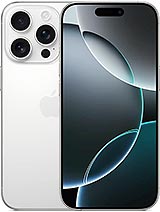Unlike the 2023 pair of Pro iPhones, the 16 Pros don’t differ in anything else other than size (and that one other aspect that comes as a result of it). What that means is the seemingly arbitrary choice to fit a 3x telephoto on the 15 Pro and a 5x one on the 15 Pro Max is no longer on the list of considerations in choosing a Pro from the 16 generation. So Apple has made it easier this year, right? Or is it the other way around?
Let’s look into the similarities and see if we can find any less obvious differences.
Table of Contents:
For starters, you can compare the complete specs sheets or directly continue with our editor’s assessment in the following text.
Size comparison
First and foremost – size. The Max doesn’t take its name lightly and is, indeed, a huge smartphone. It’s grown a little compared to last year’s model, the three extra mm in height and nearly a mm of added width possibly being the last drop that pushes the lineup beyond some customers’ tolerance of ‘large’. That said, if ‘large’ is what you’re after, the Max delivers.
The 16 Pro has gained a bit of weight and is also 3mm taller and a mm wider than last year’s model – so in a way, it’s the safety net for those that will be put off by the new Max’s size, but don’t quite want a small phone. On the other hand, if you’re looking for a compact ‘Pro’, perhaps this one still qualifies – with enough context and rationalization.
The two phones share the same materials, build and color options, so there’s not much to choose here. You can count on the titanium frame and third-gen Ceramic Shield display glass to offer plenty of protection against drops, shattering and scratches. Both phones are also IP68-rated, and, in typical Apple fashion, they exceed the standard’s 1.5m depth requirement and should be good to as deep as 6m (for 30 mins, freshwater).
Display comparison
Body size goes hand in hand with screen size and the 16 Pro Max has the largest display there has ever been on an iPhone. The 6.9-inch panel offers ample viewing area and maybe a couple of extra lines in a list when compared to the iPhone 16 Pro’s 6.3-inch screen – you’ll have to scroll that little bit more on the non-Max, and stuff on screen will be somewhat smaller too.
Other than that, there’s little to separate the two models. Apple has settled on the 460ppi pixel density as the fundamental property (Super Retina and all that) and varies the overall resolution depending on the diagonal. Maximum brightness is the same 900nits when in manual operation and around twice that if you let the auto brightness take over. You also get HDR10 and Dolby Vision support on both.
Both Pros have ProMotion, Apple’s name for a high refresh rate display. You don’t get much control over its behavior other than being able to turn it off and limit the refresh rate to 60Hz, but Apple probably knows what it’s doing and gives you the optimal balance between smoothness and battery life.
Battery life
With great size comes great battery – are we quoting that right? Both models get a bump in battery capacity – 9.4% up for the Pro, 5.5% up for the Pro Max. The 16 Pro Max, in particular, is now almost up there with the Androids of its caliber, and with 1,100mAhs on top of the 16 Pro, you’d expect it to offer better endurance, even when accounting for the larger display.
Indeed, we got a better Active Use Score on the 16 Pro Max, with meaningfully higher numbers across all tests. That’s not to say that the 16 Pro is bad – quite the opposite – just that the 16 Pro Max is the better option if you routinely have long days away from a power source.
Charging speed
Apple’s charging ratings set the standard for murkiness with a universal spec for all recent models that says ‘up to 50% charge in 30 minutes with 20W adapter’. We tested with more powerful USB PowerDelivery adapters to give them the best chance of outperforming that ‘spec’.
The 16 Pro did charge a little faster than advertised, which wasn’t the case in our experience with the 16 Pro Max, which underdelivered. Either way, it’s a race with no real winner, and both are almost painfully slow to reach a ‘full’ state, though the Pro Max again is even slower than slow.
The iPhone 16 Pro and 16 Pro Max both support wireless charging, maxing out at 15W with generic Qi2 pads, or 25W with proprietary MagSafe pucks (plugged into 30W+ adapters).
Speaker test
Both Pro iPhones (just like the non-Pros) feature hybrid stereo speaker setups with one driver on the bottom, and another one up top that also doubles as an earpiece.
Both deliver excellent sound overall, with a nice low-end presence and clear vocals and treble output. The Pro Max has a bit of an edge in the vocals and the mid-high region, which also allows it to score higher for loudness. A small advantage for the Pro Max here, but a perfectly great Pro too.
Performance
Both iPhone Pros feature the Apple A18 Pro chipset, the company’s latest in-house design. They all have the same 8GB or RAM too, so there shouldn’t be any real difference in performance.
One thing that sets them apart is the base storage, the 16 Pro starting at a somewhat unacceptable 128GB, while the Pro Max can’t be had with less than 256GB. It’s worth keeping that in mind when comparing prices because if you want to match the Pro Max’s base storage on the Pro, the previously meaningful savings get halved to $100/€120 and one of the Pro’s key advantages becomes less significant.
Benchmark performance
As expected, benchmark results are very similar between the two. You can count on industry-leading performance from either phone, and you can also be certain that either 16 Pro will feel smooth and snappy for years to come.
Camera comparison
We did our share of complaining last year when the iPhone 15 Pro came with a 3x zoom camera instead of the 15 Pro Max’s 5x telephoto, and Apple has listened (because, of course, they listen to us) – the 16 Pro has the same telephoto camera as the 16 Pro Max. In fact, all of the cameras are the same between the two – the new ultrawide is shared, the tried and tested sensor-shift main camera is the same, and the selfie shooter is the same.
Naturally, the camera software and hardware are also the same between the two. The new Camera Control is equally useful (or annoying, depending on where you stand), and the new format capabilities (4K120 video, JPEG-XL, spatial audio) are shared between the two.
Image quality
For all intents and purposes, the resulting images from the two phones are identical. They have the expected iPhone rendition, with conservative color, wide dynamic range and at least a little bit questionable detail treatment. As we’ve come to expect from iPhones, the 2x zoom level is among the better implementations on the market and you can count on nicely detailed 50-ish mm photos. The iPhone 16 Pro and the 16 Pro Max capture the same 5x zoom shots too.
The new Pro-grade ultrawide cameras didn’t prove to be a radical improvement over last year’s module, but it’s not something that you need to think about when choosing between these two phones.




iPhone 16 Pro daylight photo samples: 0.5x • 1x • 2x • 5x




iPhone 16 Pro Max daylight photo samples: 0.5x • 1x • 2x • 5x
On to some equally identical selfies. We tend to like iPhone selfies and even though there’s not been a whole lot of hardware advancement, the 16 Pro and 16 Pro Max still capture pretty great photos with their front-facing cameras.




Selfie samples: iPhone 16 Pro • iPhone 16 Pro Max
Differences don’t magically appear at night, so the 16 Pro and 16 Pro Max will be capturing the same photos with all of their cameras. The primary ones take pretty excellent shots and the 2x zoom level also remains a viable option even when light levels drop. The parity continues at the telephoto level, where this year we don’t have to pick between 3x and 5x – the 16 Pro can zoom as far as the 16 Pro Max.




iPhone 16 Pro low-light photo samples: 0.5x • 1x • 2x • 5x




iPhone 16 Pro Max low-light photo samples: 0.5x • 1x • 2x • 5x
Video quality
With all the talk about how the two phones capture the same photos, it’s only natural that video quality is also identical between the 16 Pro and 16 Pro Max.
Below we have a few framegrabs from the videos taken by the two phones at each focal length so it’s easier to compare.




iPhone 16 Pro daylight video samples: 0.5x • 1x • 2x • 5x




iPhone 16 Pro Max daylight video samples: 0.5x • 1x • 2x • 5x




iPhone 16 Pro low-light video samples: 0.5x • 1x • 2x • 5x




iPhone 16 Pro Max low-light video samples: 0.5x • 1x • 2x • 5x
Verdict
We’re not entirely sure why we had to wait for a year to get true camera equality between the two sizes of iPhone Pro, but whatever the reason for the delay, we’ve now waited it out – the choice this generation is even more so based on size than it’s been as of late.
With both models getting larger this year, the 16 Pro Max may finally have become too much size-wise. But if you want the most iPhone you can get, the 16 Pro Max is precisely that – the biggest display and best endurance, with all the features and capabilities the ecosystem can offer.
For those looking to get the same functionality and the entire iPhone Pro experience, only in a more pocketable package, the 16 Pro is the obvious choice and the fact that it’s cheaper doesn’t hurt its case either.






